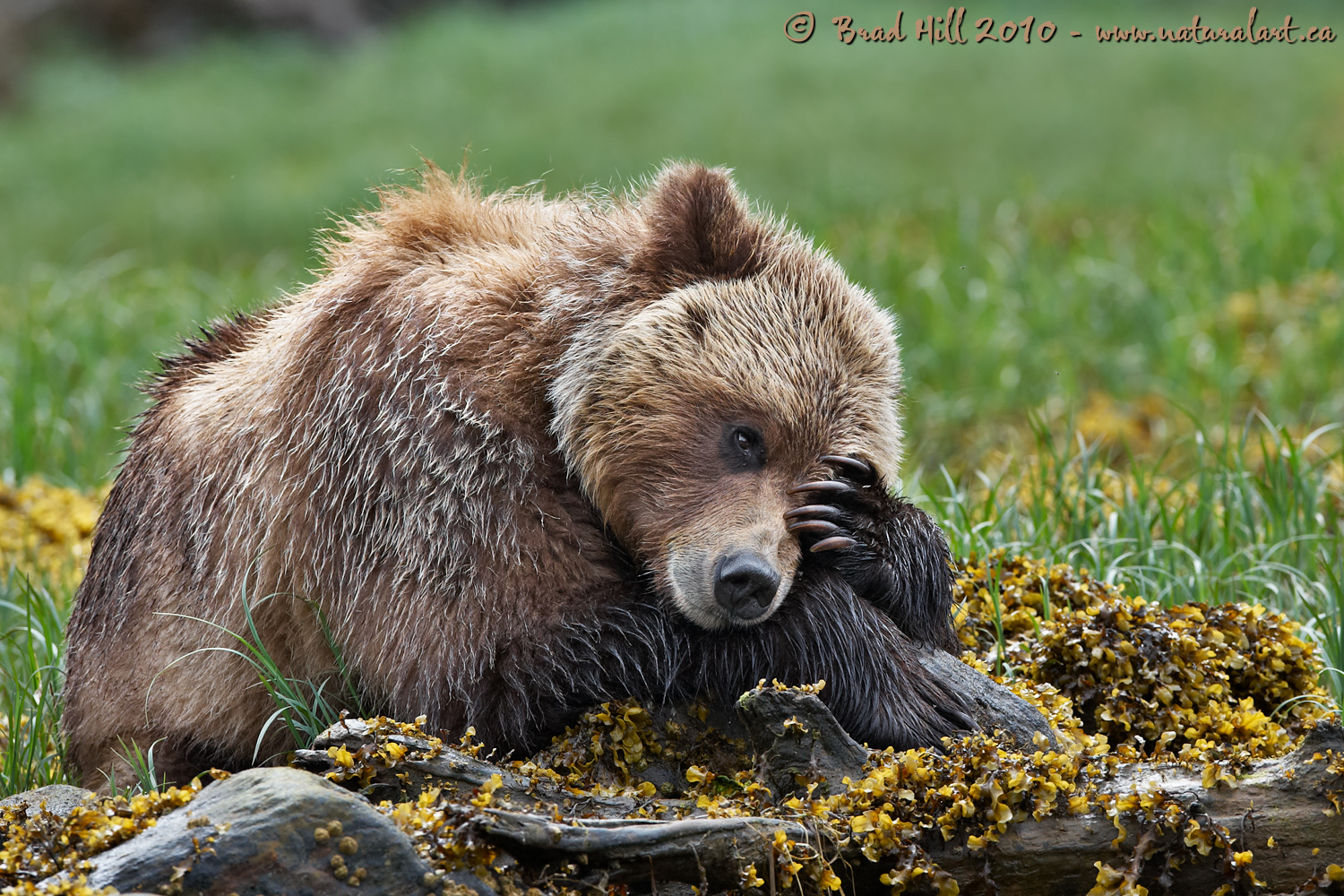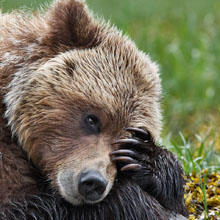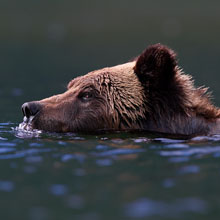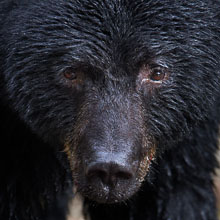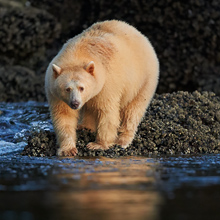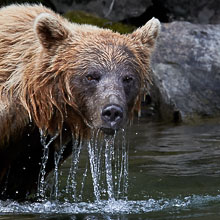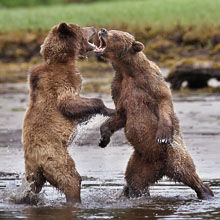Availability: Undetermined - Enquiries?
In the Field
Man...What a Day! Khutzeymateen Inlet, BC, Canada. June 2, 2010.
When viewing wildlife images, it's sometimes hard NOT to be anthropomorphic. For me, this is one of those times...it's hard to imagine that this bear is having anything BUT a bad day (and is hoping that tomorrow is better). This is a female bear (around 4 years old) that had been, for the week or so before I shot this image, romantically pursued by a number of adult male bears (and, to be honest, seemed confused by their intentions). The situation left me wondering if she was thinking about what the heck she had to do to get rid of those pesky males. I wasn't about to tell her...
I'm of the view that digital wildlife photography is a near perfect marriage of creativity and technical knowledge. Kind of a "right brain/left brain" thing. Even a "cute" image like this - where it seems like the image is totally dominated by what the bear is doing - illustrates the interplay between creativity and technical thinking...
With most wildlife images (including this one), one of the key things in making them work is to keep the image simple (and making it very clear where you want the viewer to look). One way to do this is to isolate (or separate) the subject from the background. And one way to do this is to soften up (i.e., throw out of focus) the background and ensure it isn't a distraction. But...you have to ensure that the critical portions of the subject - and in many cases all or most of the foreground - are in sharp focus. Many novice, and virtually all, intermediate level photographers know this principle, but when they get into a field situation they don't know what aperture to select (at a given distance) to produce the effect they know they want. What to do? Well, many "how-to" manuals and books talk about using your camera's depth of field preview button to force your camera to stop down (close the aperture to that which you've chosen) to "see" your depth of field. In theory, they're right. But in practice, when you do this the viewfinder darkens to the point where you really can't see exactly what is in focus and what isn't. An alternate approach available to those who have cameras with Live View (where you can view your image on your camera's LCD prior to exposure) is to check the depth of field using that function (as your LCD shows the effect of aperture choice on depth of field in real time). But...between the slow autofocus and lack of other critical info available on your LCD (of most implementations of Live View), it's rare that using Live View really works well when shooting wildlife images.
So what do you do to get the depth of field "right"? Well, I do something decidedly old-fashioned - I consult depth of field tables (which give the width of your depth of field, and how it is distributed in front of and behind your focal point). Mind you, I do it in a high tech way (on my iPhone or iPad)! And, because I can't do it fast enough in the field, I MEMORIZE (oooh, yuk!) the depth of field values for each of my telephoto lens for a few key distances. Yep, geek stuff. BUT, having this info in my head gives me an advantage - and removes the guesswork - when I'm choosing an aperture to produce an image with a specific creative look and feel to it.
Right brain - meet left brain! You're going to have to work together a LOT if you want to do some seriously interesting wildlife photography...
ADDITIONAL NOTES:
1. This image - in all resolutions - is protected by copyright. I'm fine with personal uses of them (including use as desktop backgrounds or screensavers on your own computer), but unauthorized commercial use of the image is prohibited by law. Thanks in advance for respecting my copyright!
2. This image was captured during one of my two spring "Grizzlies of the Khutzeymateen" photo tours in May/June of 2010. Each year I offer trips into two different parts of the Great Bear Rainforest as well as one to photograph aquatic mammals and oceanscapes near the northern tip of Vancouver Island. And, in selected years, I also offer photo tours to locations to capture other highly sought-after subjects, such as various boreal owl species and wildlife of Canada's Arctic. Details about these trips can be found on the Photo Tours page of this website.
3. Like all wildlife photographs on this website, this image was captured following the strict ethical guidelines described in The Wildlife FIRST! Principles of Photographer Conduct. I encourage all wildlife photographers to always put the welfare of their subjects above the value of their photographs.
Behind the Camera
Man...What a Day! Khutzeymateen Inlet, BC, Canada. June 2, 2010.
Digital Capture; RAW 14-bit format; ISO 250.
Nikon D3s with Nikkor 400mm f2.8 VR lens - handheld. VR on and set to "Normal" mode.
1/400s @ f6.3; -0.33 stop compensation from matrix-metered exposure setting of camera.
At the Computer
Man...What a Day! Khutzeymateen Inlet, BC, Canada. June 2, 2010.
RAW Conversion to 16-bit TIFF, including first-pass/capture sharpening using Phase One's Capture One Pro 5. Four RAW conversions at different exposure settings. Exposure settings varying from 0 stops compensation (to retain highlight detail and for background) through to +1.7 stops for darker portions of the bear's face (to draw out shadow detail).
Further digital corrections on 16-bit TIFF file using Adobe's Photoshop CS5 and Light Craft's LightZone. Photoshop adjustments included compositing and masking of 4 exposure versions, selective saturation of colours and selective sharpening for web output. Final tonemapping and tweaking performed with LightZone use the (tonemapper/re-light tool).
Conservation
Man...What a Day! Khutzeymateen Inlet, BC, Canada. June 2, 2010.
Ten percent of the revenue generated by this image will be donated to Raincoast*.
Species Status in Canada**: Special Concern (May 2002).
While Grizzly Bears (Ursus arctos) are not technically listed as "Endangered" in Canada, they have been extirpated from most of their historical range. Grizzly Bears are far more sensitive to intrusion/disturbance in their habitat than are Black Bears and are being increasingly forced into marginal habitat by human encroachment. The Great Bear Rainforest along the central and northern coast of British Columbia is one of the last strongholds of the Grizzly Bear in Canada, and even this population is coming under increasing pressure.
On December 18, 2017 the government of British Columbia banned grizzly hunting across the entire province. This major conservation victory came after decades of tireless work by many dedicated conservationists and ecologists and, most importantly, it reflects the opinion of the vast majority of British Columbians. And, it means that AT LEAST while the current government remains in power grizzlies are finally "safe" in British Columbia.
Now that we've at least temporarily won the battle to save grizzlies in BC, it's time to re-focus our efforts toward protecting ALL of BC's carnivores, including Gray Wolves, Black Bears, Cougars, Wolverines, and more! Simply put, there are no ecological, economic, or ethical arguments supporting the trophy hunting of carnivores.
In a great first step towards ending the hunting of carnivores throughout BC the Raincoast Conservation Foundation has developed a program designed to protect ALL carnivores within the Great Bear Rainforest. Details about this program can be found on this page on Raincoast's website. Check it out and, better yet, make a donation to help Raincoast purchase the remaining commercial hunting tenures in the Great Bear!
*The Raincoast Conservation Society (and Foundation) is an effective and efficient organization that has been fighting for protection of this unique habitat. If you are looking for a meaningful way to contribute to the conservation of this amazing ecosystem, Raincoast will provide maximal "bang" for your conservation dollars.
**as determined by COSEWIC: The Committee on the Status of Endangered Wildlife in Canada












